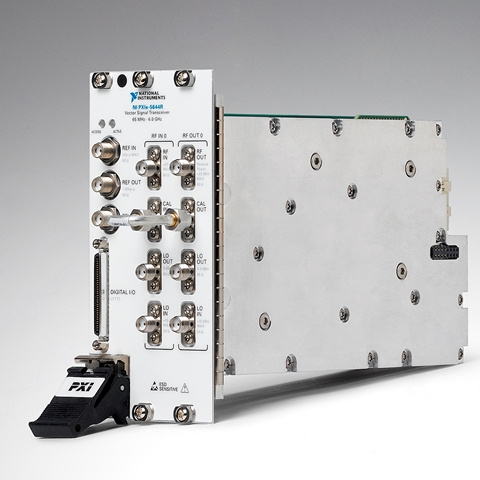For years, RF instruments have used FPGAs to implement the instruments' capabilities and controls — their so-called firmware personalities — but the development of these personalities had been done by specialized HDL engineers and presented to the user in locked-up form. On the other hand, National Instruments was providing programmable FPGAs in data acquisition and control products such as the R Series and CompactRIO. Using LabVIEW to program the FPGAs, users could define an instrument's functionality, making the development of these complex applications accessible to the novice. With the PXIe-5644R RF vector signal transceiver (VST), NI decided to take the next step in instrument evolution.

The core development of the VST was a joint effort between R&D, manufacturing, product marketing, and sales. Together, the departments jointly defined and evolved the product from concept to release. Each of these groups needed to be involved in the concept and development to ensure that the product was comprehensive in its ability to meet the needs of a broad range of applications in the RF industry.
Ten years ago, on the RF instrumentation front, NI brought high-performance vector signal analysis to PXI, thereby enabling a fast, modular approach to RF test applications. As the test challenges evolved at an increasing pace, NI saw an opportunity to integrate these separately successful technologies to produce a fast, flexible, extensible instrument that boasts performance among the best in the industry. The design cycle for the VST was consistent with NI's historical trend of 1 to 3 years. Very early in the development of the VST, NI felt it had an excellent product coming together, and work done with lead users indicated that it would be successful. For example, Qualcomm Atheros improved its WLAN test speed 200x, which gave Qualcomm better insight into its device under test using the VST.
The VST is designed around a high-performance FPGA that defines the core functionality of the instrument, and evolution of FPGA technology has provided increasing power. Not only did NI take advantage of the latest FPGA technologies, but the company also had to design a uniquely architected programming API, the Instrument Design Libraries, to expose the VST's software-designed functionality to the user. (For whitepapers on the hardware and software architectures, visit ni.com/vst.) Another key to opening the instrument's power to customers in an easy-to-use way was heavy reliance on LabVIEW FPGA. Without it, it would be almost impossible for customers to modify the VST's firmware — the main thing NI expected users to do — without extensive help from NI.
For the VST, the manufacturing team developed unique manufacturing processes to handle the complex manufacturing and testing requirements demanded by the VST. For example, the manufacturing team created a new production cell that uses NI instrumentation almost exclusively, reducing capital costs and manufacturing overhead. This added enormous value to the production process and removed the need for costly traditional box instruments.
So far, the VST has won seven global industry awards and has been extremely successful from applications in production test to research. Customers are using the VST for applications NI had never dreamt of, which shows the product's flexibility and broad capabilities. And, in terms of revenue, after the first nine months it is the most successful new hardware product in NI's history.
NI says that, when you set about to something as bold as giving customers the ability to rewrite the firmware of an RF instrument, you have to have a little doubt in your mind that it can be possible and efficient. VST taught the company that it was not only possible but, when done correctly, can be extremely empowering for users. And instead of increasing NI's support burden for simple firmware modifications, the VST actually reduced it; customers can now do the modifications themselves (successfully) without asking NI, freeing the company to deliver new innovations, such as the latest Instrument Driver FPGA Extensions released at NIWeek 2013. The success of the VST and the pairing of NI FlexRIO modules with other RF hardware (such as the NI PXIe-5665) has shown the company significant potential for growth.
Advertisement
Learn more about National Instruments





